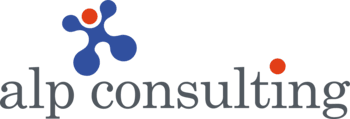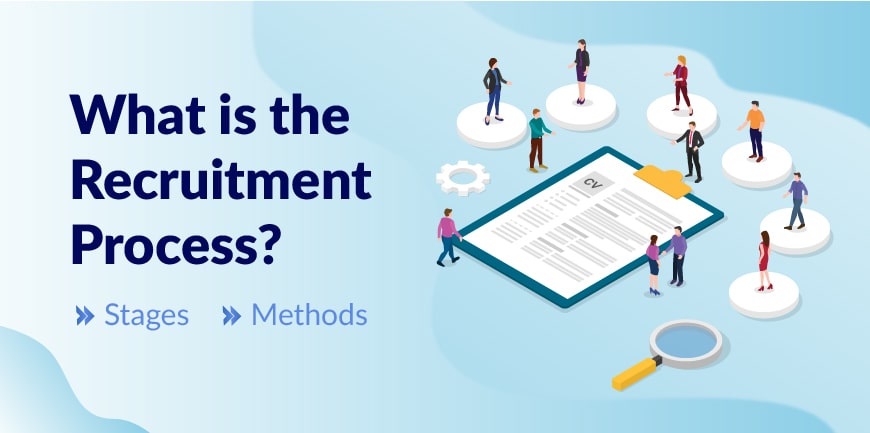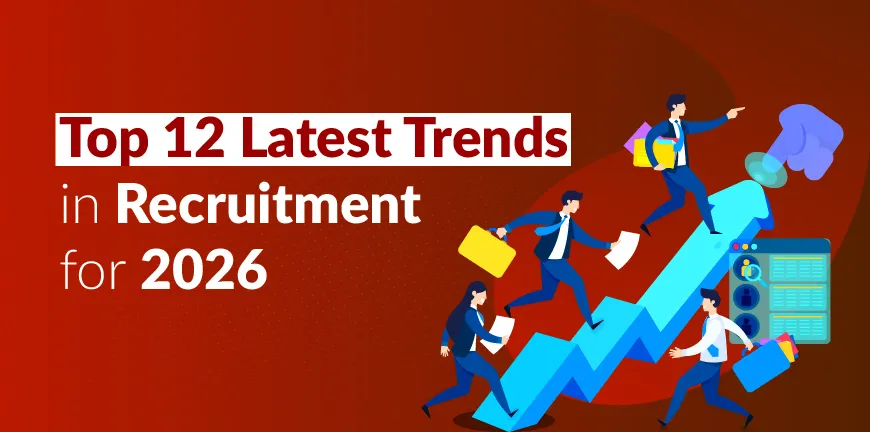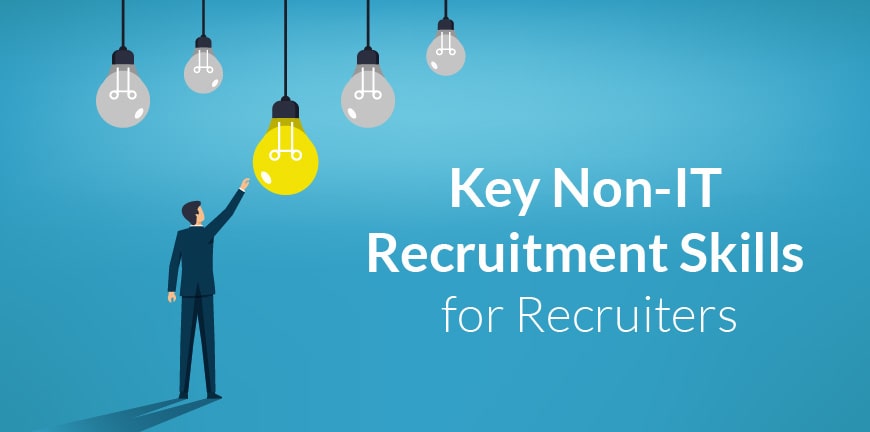
Top 10 Benefits of Social Media on Talent Acquisition
13/05/2025
What is Employee Referral? Definition, Benefits and Tips
15/05/2025- What is the Meaning of the Recruitment Process?
- 8 Stages of Recruitment Life Cycle
- Why is the Recruitment Process Important?
- How Recruitment Process work?
- What are the 8 Steps in the Recruitment Process?
- What are the Common Mistakes to Avoid in Recruitment?
- What are the Best Practices for Improving the Recruitment Process?
- Common Recruitment Challenges and How to Overcome Them?
- Tools and Technology to Simplify Recruitment
- What are the Recruitment Process Methods?
- What is the difference between recruitment, hiring, and sourcing?
- How a Structured Process Improves Hiring Success?
- Are You Looking for a Recruitment Partner?
- Conclusion: Building Stronger Teams with Better Recruitment
- Key Takeaways
- Frequently Asked Questions (FAQs)
The Indian job market growth is all-time high with nearly 17.9 crore new jobs added in the last decade. However, one of the main reasons for such an exponential hiring rate is that most companies have implemented a robust recruitment process consisting of expert HR professionals and cutting-edge technology to provide a seamless hiring experience for candidates and bring top talent onboard to board. You might be curious about how the recruitment process works and why it is a vital cog in a company’s growth cycle. Without further delay, let’s find out!
A well-planned recruitment process is more than just an HR task—it has a direct impact on hiring managers and their teams. The right hires can boost team dynamics, productivity, and the company’s success.
Using a structured approach enables hiring managers to make smarter, evidence-based decisions rather than relying on intuition. This reduces bias and ensures fair evaluation of all candidates. It also saves time—Google found structured interviews cut 40 minutes per interview. Bad hires are costly, with an average loss of nearly £15,000.
What is the Meaning of the Recruitment Process?
A recruitment process is a standardised method of sourcing, screening, interviewing, selecting, and onboarding best-fit candidates for the open positions available in a company.
Typically, a recruitment process in HRM starts with a requirement shared by internal teams either to add a new resource to manage the workload or replace an employee who has decided to leave the organisation.
A robust recruitment and selection process is essential to hire the best talent that can support business growth and improve brand presence for the long term.
8 Stages of Recruitment Life Cycle
- Identifying the hiring need – Analyzing vacancies and determining required skills
- Creating a job description – Developing a compelling description of the position
- Sourcing candidates – Finding potential hires through various channels
- Screening applications – Reviewing resumes and conducting initial assessments
- Interviewing candidates – Evaluating shortlisted applicants through formal conversations
- Selecting the best fit – Making the final hiring decision
- Extending a job offer – Presenting employment terms to the chosen candidate
- Onboarding – Integrating the new employee into the organization
Why is the Recruitment Process Important?
An effective recruitment selection process can make or break a business, as companies thrive only with employees who are performing at their best day in and day out.
From talent acquisition to continuity of business operations, a well-established HR recruitment process plays a critical role at every stage.
Here are a few reasons that shed light on the importance of a recruitment process:
1. Identification of present and future requirements
A recruitment process in HRM helps a company in making assessments of the present and future staffing needs. The HR team will methodically analyse the business operations to assess how much workforce is necessary for the best outcomes.
2. Prevents disruptions in business operations
A robust recruitment selection process ensures that daily business activities run seamlessly without any disruptions. Whenever there is a shortage of staff or a need for a replacement, the HR team initiates a recruitment process on priority to fill the vacant positions on an immediate basis.
3. Improved hiring rates
The scope of the recruitment process encompasses a success strategy that improves hiring rates, where the initial screening itself ensures only best-fit candidates make it to the assessment round and beyond.
4. Creating a wide talent pool
The main objective of recruitment is to create a wide talent pool to ensure that whenever there is a staffing requirement, the necessary recruitment process steps are carried out, and suitable candidates are hired within a deadline to prevent operational disruptions.
5. Save time and money
An effective HR recruitment process can save time and money for companies. A streamlined hiring process will ensure all vacant positions are filled immediately without compromising on the quality and efficiency of the hires.
How Recruitment Process work?
A recruitment definition and process include ” selecting the right candidates for the right job position at the right time”. A common recruitment process involves numerous steps from defining the needs to ensuring a smooth onboarding experience for the selected candidates. However, each organisation needs to come up with a recruitment process that is suitable for its business operations. The factors that contribute to designing a recruitment process include:
- Size of the organisation.
- Type of industry, product, and services offered.
- The company’s growth rate.
- Salary and benefits provided.
- Type of employment and vacancy availability.
- Conditions of employment (onsite, remote, or hybrid).
Once the recruitment process is finalised and implemented, the HR team ensures all the steps are followed diligently by the hr team and only the best candidates are hired within the prescribed timeline by the management or the team that requests a resource to manage their operations.
What are the 8 Steps in the Recruitment Process?
The 8 steps in the recruitment process include:
1. Understanding hiring needs and vacancies
Filling vacancies with the best candidates begins with understanding the hiring needs. Check with the manager of the team that requires a resource and outline the day-to-day tasks, roles, and responsibilities of the candidate, and the plans for that role.
2. Create a clear job description
Once the hiring needs are identified, the recruitment team must create a clear and detailed job description that includes details such as job title, job summary, roles and responsibilities, salary offered, experience required, skills needed, minimum qualification, current and expected CTC, work mode (onsite, remote, or hybrid), etc.
3. Start scouting for talent
Once the job description is locked, start scouting for top talent who are ideal for the role and the compensation offered. Use internal referral programs and other recruitment methods to identify the best talent available in the job market.
4. Carry out initial screening and shortlist candidates
This is a crucial step in the recruitment selection process where the HR team must vet the applications and select candidates who closely match the job description. We can use automated resume analysers like ATS to shortlist candidates based on scores and send interview invites. Additionally, ask for portfolios that demonstrate achievements and proof of excellence to make better assessments.
5. Take interviews and assess candidates
Inform the selected candidates about the interview process so that they can come prepared accordingly. Either conduct an on-site or online interview based on management’s approval and the candidate’s availability. To save time and resources, an e-recruitment process where the entire process from initial screening to onboarding is online can be utilised.
6. Release the offer letter to selected candidates
Once the candidate has cleared all the interview and assessment rounds, complete all the formalities and share the offer letter with all the necessary details through email. Provide sufficient time to the candidate and ask them to send a confirmation email once the offer is accepted. Always keep backup candidates in case the selected one rejects the offer.
Additionally, set up negotiation meetings in case the candidate is not satisfied with the current offer and seeks a revised one. Always try to find a middle ground and create a win-win situation for both the candidate and the company.
7. Making the job offer
Send out a clear job offer quickly once you’ve made your choice. Include salary, benefits, start date, and working conditions. Be ready to negotiate and have a backup offer prepared if needed. Keep things moving by sending pre-hire paperwork fast.
8. Initiate onboarding
Once the candidate accepts the offer and provides confirmation on the joining date, initiate the onboarding process to get the ball rolling. Ensure the candidate has a seamless onboarding experience. Also, provide all the necessary information related to the job role, office etiquette, responsibilities, reporting manager, attendance and leave policies, document requirements, etc.
What are the Common Mistakes to Avoid in Recruitment?
Smart hiring isn’t just about knowing what to do – it’s about knowing what to avoid. Even seasoned hiring managers make common recruitment mistakes that can throw off a good process.
- Job descriptions must be clear, easy, and interesting to read. Vague descriptions create false expectations, leaving candidates unhappy.
- Not focusing on internal talent mobility and promoting from within can result in missing out on good talent, which could have also saved money, time, and reduced risks.
- Resumes shouldn’t be the only deciding factor. They help, but don’t show the whole picture. It often results in great candidates with non-traditional backgrounds being overlooked.
- Standard questions like “What’s your greatest weakness?” only get rehearsed answers instead of real insights. Companies that rush through interviews pay the price. SHRM reports that bad hires cost companies 30% of that employee’s first year’s pay.
- Hidden bias remains a big challenge. Studies show men get 50% more callbacks than women in male-dominated jobs. This bias occurs when companies hire based on cultural “fit” rather than shared values. This has become a bigger issue in today’s remote-first environment.
- Don’t write off over-qualified candidates, thinking they’ll leave soon. They might just want stability or meaningful work after changing careers. Give them a fair chance.
- Budget-friendly pay, poor candidate communication, complex applications, and skipping reference checks can all hurt your hiring success.
- A solid onboarding process matters most after making an offer. New hires struggle within weeks without proper guidance. Harvard Business Review points out that poor culture fits lead to turnover costs of 50-60% of a person’s yearly salary.
What are the Best Practices for Improving the Recruitment Process?
Here are the best practices to improve the recruitment process:
- Leverage technology like ATS (Application Tracking System) to sort profiles, but still use your experience and judgement before finalising the final candidate lists for interviews.
- Only include the necessary information in the job description to avoid confusion and apprehension.
- Maintain effective communication with prospective candidates and share regular updates on their interview status.
- Utilize referral programs extensively to increase the likelihood of securing high-quality hires.
- Use different interview methods, like online and in-person, based on the candidate’s availability and experience level. Keep it flexible and candidate-centric.
- Streamline each recruitment process step in HR to improve hiring rates and reduce costs.
- Build a talent pipeline to reduce time-to-hire.
Common Recruitment Challenges and How to Overcome Them?
1. Talent shortages in key sectors
Certain industries like healthcare, IT, biotech, etc., need specialised skills, and finding top candidates in huge numbers in such sectors is extremely challenging. These talent shortages can hamper the recruitment process and create complexities in filling positions.
To overcome this, companies must develop mitigating strategies like access to a global talent pool, identifying and recruiting top candidates through reputed institutes like IIT or NIT, and implementing upskill and reskill training programs for existing employees, etc.
2. Diversity, Equity, and Inclusion (DEI)
Despite increased awareness of Diversity, Equity, and Inclusion (DEI), companies are still facing challenges to include DEI in their HR recruitment process. To improve DEI initiatives in recruitment, an AI-driven recruitment process, regular DEI training for the recruitment team, etc., can be utilised.
3. Company branding in a competitive market
Top talents usually prefer companies that have high brand value and great online reviews. Even with the best recruitment process in place, if the branding is not up to the mark, getting top candidates on board may prove to be very difficult. To overcome this challenge, the recruitment team may use digital marketing to improve its online presence, get employee reviews posted on platforms like Glassdoor and Ambition box, post client testimonials about its products and services, etc.
Tools and Technology to Simplify Recruitment
“Accept the fact that AI will change our work, but look at it as an enabler of your work and the future of talent acquisition.” — Przemek Berendt, CEO of Talent Alpha, a recognized expert in HR technology
HR teams rely on technology to streamline operations and enhance results. The market now has many tools that automate routine tasks. This enables recruiters to build stronger relationships with candidates.
- Applicant Tracking Systems (ATS) work as central databases that store candidate details and track applications. These systems facilitate teamwork between hiring managers. Through collaboration with Candidate Relationship Management (CRM) platforms, companies can establish connections with potential hires before job openings arise.
- Job boards are the foundation of connecting businesses with applicants and screening candidates based on resumes. The process is refined through programmatic advertising, which sets rules to enable qualified candidates to apply.
- AI plays a crucial role in recruitment today, and 70% of companies use it for content creation and administrative work. Smart systems screen resumes and remove unconscious bias. Candidates receive quick answers from chatbots that achieve a 98% response rate.
- Video interview software helps conduct remote interviews quickly. Assessment tools review candidates’ skills before face-to-face meetings.
- Companies use onboarding software to welcome new employees smoothly, which reduces HR teams’ workload.
These tech solutions help companies reduce hiring time, lower recruitment costs, and substantially expand their talent pool.
What are the Recruitment Process Methods?
The different recruitment methods adopted by most companies for hiring top candidates include:
1. Direct advertising (online)
Posting job openings directly on the company’s official website, job portals, social media websites like LinkedIn, etc. Based on the applications received, the recruitment selection process can be initiated.
2. Database search
Maintain a candidate database through passive hiring and select the top profiles that match the job description.
3. Referral Program
Create a referral program where employees will refer suitable candidates based on requirements and offer bonuses once the candidate is onboarded successfully.
4. Recruitment agencies
Partner with top third-party recruiting agencies like ALP Consulting to get the best hires in a short duration.
5. Internships and Training
Offer internship opportunities to bright final-year students or graduates and recruit them based on their performance during the internship period.
6. Campus Drive
Conduct placement drives in top colleges and universities to hire talented students for entry-level roles.
What is the difference between recruitment, hiring, and sourcing?
Here are the key differences between recruitment, hiring, and sourcing:
| Feature | Sourcing | Recruitment | Hiring |
| Definition | Identifying and attracting potential candidates for current or future requirements. | The complete process of attracting, screening, shortlisting, and onboarding candidates. | The process of offering the job and onboarding the selected candidate. |
| Scope | Limited to candidate lead generation and creating a talent pipeline. | Includes broader aspects like sourcing, interviewing, evaluation, and candidate experience. | Emphasis on final selection, offer rollout, and employee integration. |
| Objective | To proactively discover qualified talent (usually passive candidates). | To evaluate and select the most suitable candidates for open positions. | To successfully fill the role and ensure a smooth start for the candidate. |
| Responsibility | Usually handled by talent sourcing executives or researchers. | Managed by recruiters or HR professionals in collaboration with hiring managers. | Typically involves HR, hiring managers, and upper management. |
How a Structured Process Improves Hiring Success?
Systematic, evidence-based approaches to recruitment will significantly enhance hiring success. Companies that follow organized recruiting practices see a 36% improvement in hire quality. This step-by-step approach establishes a strong foundation for talent acquisition at every stage.
Structured interviews double the predictive power compared to traditional unstructured ones. Better outcomes result from companies using structured interview models, as they maintain fairness and consistency throughout the assessment process.
Superior results come from treating recruitment as a single, connected system, rather than separate steps. Organizations can connect training, recruiting, onboarding, performance management, and retention when they look at the recruitment lifecycle comprehensively. Each phase strengthens the others in this connected approach.
Structured processes help reduce unconscious bias, which can often harm hiring decisions. Research shows that structured interviews are more effective in preventing discrimination claims. All discrimination lawsuits based on structured interviews were found to be non-discriminatory, whereas only 40% of unstructured approaches yielded the same outcome.
Good coordination between hiring managers and recruiters on criteria, processes, and timelines enables faster decision-making. This teamwork improves internal efficiency and candidates’ view of the company culture.
Companies that use structured recruitment procedures report lower turnover costs, better employee retention, and safer workplaces. This demonstrates that structure isn’t just paperwork, but a genuine business advantage.
Are You Looking for a Recruitment Partner?
In the current business landscape, time and cost savings are of the essence, and managing an in-house recruitment team can be tedious and may not have favourable outcomes. Therefore, partnering with a top recruitment agency like ALP Consulting can be a game-changer in terms of hiring top talent in a short period. The key advantages of choosing ALP as your research partner include:
- Tailored recruitment solutions as per the company’s requirements.
- End-to-end recruitment services from initial screening to onboarding and beyond.
- Expert guidance and support.
- A dedicated team of expert recruitment professionals
- Scalable as per the company size.
- Suitable for all types of industries and services.
- A streamlined recruitment process that complies with employment laws and regulations.
Conclusion: Building Stronger Teams with Better Recruitment
A smart recruitment process is a game-changer for hiring managers aiming to build top teams. Structured hiring isn’t just paperwork—it transforms outcomes, boosting productivity by 25% and improving company results.
Every step counts, from clear job descriptions to unbiased, data-driven interviews. Avoiding rushed decisions and bias helps you hire the right people faster and saves you from costly mistakes.
Utilizing modern tools and standardized interviews makes hiring more fair, quicker, and efficient. It strengthens teams, cuts turnover, and protects workplaces.
When hiring managers treat recruitment as a strategic priority, they build stronger teams—driving long-term success and business growth. Investing time in recruitment pays off with better hires and a thriving organization.
Key Takeaways
- A streamlined recruitment process ensures businesses attract, evaluate, and onboard the best talent efficiently in a short duration.
- Technology like ATS and e-recruitment platforms enhances hiring speed, accuracy, and candidate experience in modern recruitment.
- Clear job descriptions and defined roles are critical to attracting the right candidates and streamlining the selection process.
- Effective recruitment helps maintain business continuity by filling vacancies quickly without compromising on candidate quality.
- Partnering with recruitment agencies offers scalable, expert-driven hiring solutions across industries and employment types.
Frequently Asked Questions (FAQs)
1. What is the recruitment process?
Recruitment is the backbone of any organization. It is a systematic approach to identifying, attracting, and selecting suitable candidates for open positions. The process involves identifying and sourcing candidates, interviewing them, selecting the best candidates, hiring them, and onboarding them.
2. What is the recruitment process in HR?
The recruitment process in HRM includes several stages, such as identifying hiring needs, creating a well-crafted job description, searching for talented candidates matching the position, initial screening and shortlisting the best-suited candidates, conducting interviews and assessments, releasing offer letters to selected candidates, onboarding, and background verification.
3. What is recruitment process outsourcing?
A recruitment process outsourcing involves the delegation of a research function to a third-party service provider like ALP Consulting by a company. The handover of recruitment activities can be either partial or end-to-end, based on the choice and requirements of the company that seeks RPO services.
4. What is a full-cycle recruiting process?
A full-cycle recruitment process involves handling all hiring stages from sourcing to onboarding by a single agency or a recruitment partner.
5. What is the recruitment and selection process?
It is 2 two-step process where the companies or recruitment agencies identify potential candidates and then select them to fill a particular job vacancy through screening and interviews.
6. Why is recruitment called a positive process?
The recruitment is touted as a positive process since it helps individuals get employment and build a career and family. Also, recruitment helps organisations build an efficient workforce to drive the business forward and offer the best products and services to clients and end customers.
7. How long does the recruitment process take?
The recruitment process usually takes 15-30 days from initial screening to onboarding ,but may vary based on the company size, number of interview rounds, urgency of filling the vacancy, etc.
8. What are the key steps in an effective recruitment process?
An effective recruitment process typically includes identifying hiring needs, writing clear job descriptions, sourcing candidates, screening applications, conducting interviews, selecting the best candidate, making a job offer, and onboarding. Each step is crucial for finding and securing top talent.
9. How can hiring managers improve their communication with recruiters?
Hiring managers can improve communication with recruiters by being prepared with market research, streamlining job qualifications to must-haves, gathering detailed information about the role, setting clear expectations, and fostering a strong working relationship with the recruitment team.
10. How does a structured recruitment process benefit an organization?
A structured recruitment process leads to better hiring outcomes, including a 36% improvement in quality of hire and 25% higher team productivity. It also reduces bias, improves consistency in candidate evaluation, and significantly decreases the risk of discrimination claims.
11. What role does technology play in modern recruitment?
Technology plays a crucial role in streamlining recruitment processes. Tools like Applicant Tracking Systems (ATS), AI-powered screening software, video interview platforms, and onboarding systems help automate tasks, reduce hiring time, minimize costs, and expand the talent pool, allowing recruiters to focus on building relationships with candidates.
Contact Us For Business Enquiry

Amit Saproo
Amit Saproo is the Head of Operations at ALP Consulting with nearly 17 years of experience in Executive Search, RPO, Leadership, and IT & Engineering recruitment. He leads nationwide recruitment programs across Technology, BFSI, and R&D domains, driving strategic hiring solutions for diverse client needs. Amit excels in building and managing high-performance teams that deliver scalable, end-to-end recruitment and consulting services.




